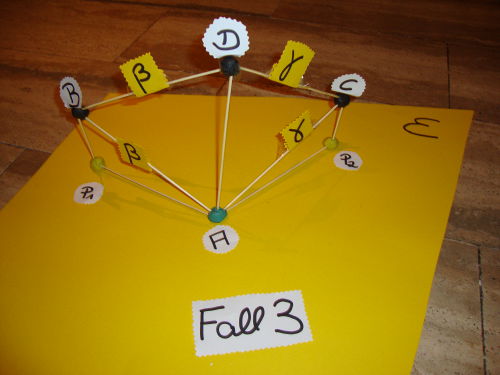Lösung von Aufg. 7.4: Unterschied zwischen den Versionen
| (32 dazwischenliegende Versionen von einem Benutzer werden nicht angezeigt) | |||
| Zeile 1: | Zeile 1: | ||
Beweisen Sie: Jede Ebene enthält wenigstens drei paarweise verschiedene Punkte.<br /> | Beweisen Sie: Jede Ebene enthält wenigstens drei paarweise verschiedene Punkte.<br /> | ||
| + | |||
| + | <u>Vor:</u> Ebene <math>\epsilon</math>,nkomp(A,B,C,D)<br /> | ||
| + | <u>Beh:</u> <math>\epsilon</math> enthält weinigstens drei paarweise verschiedene Punkte<br /> | ||
| + | |||
| + | <u>Fall 1:</u><br /> | ||
| + | 3 der vier Punkte liegen in der Ebene <math>\epsilon</math><math>\rightarrow</math> trivial<br /> | ||
| + | |||
[[Bild:DSC02782.JPG|500px]] | [[Bild:DSC02782.JPG|500px]] | ||
| + | |||
| + | <u>Fall 2:</u><br /> | ||
| + | 2 der vier Punkte liegen in der Ebene <math>\epsilon</math><br /> | ||
| + | <math>A \in\epsilon </math> ,<math>B \in\epsilon </math><br /> | ||
| + | 1) <math>A \in\epsilon </math> , <math>B \in\epsilon </math>, <math>C \notin\epsilon </math> und <math>D \notin\epsilon </math><br /> | ||
| + | 2)<math>\operatorname{nkoll} \left( ABC \right)</math> <math>\rightarrow</math> <math>\delta_1</math> ________Lemma 3 und Axiom I/4<br /> | ||
| + | 3)<math>D \notin\delta_1 </math>__________________wegen nkomp(A,B,C,D)<br /> | ||
| + | 4)<math>\operatorname{nkoll} \left( BCD \right)</math> <math>\rightarrow</math> <math>\delta_2</math> ___________3)<br /> | ||
| + | 5)<math>A \notin\delta_2 </math>________________wegen nkomp(A,B,C,D)<br /> | ||
| + | 6)<math>B \in\delta_2 </math> und <math>B \in\epsilon </math>____________2) und 4)<br /> | ||
| + | 7)<math>\exists P</math> ,<math>P \in\epsilon </math>,<math>P \in\delta_2 </math>________6) und Axiom I/6 | ||
| + | |||
| + | bleibt zu zeigen : <math>A\not\equiv P</math><br /> | ||
| + | Annahmne:<math>A\equiv P</math><br /> | ||
| + | <u><math>\delta_1</math></u>: <math>P \in\delta_1 </math>, <math>B \in\delta_1 </math>, <math>C \in\delta_1 </math><br /> | ||
| + | <u><math>\delta_2</math></u>: <math>P \in\delta_2 </math>, <math>C \in\delta_2 </math>, <math>B \in\delta_2 </math><br /> | ||
| + | daraus folgt <math>\delta_1</math> <math>\equiv </math> <math>\delta_1</math> <math>\rightarrow</math> komp(A,B,C,D)<br /> | ||
| + | 8) Widerspruch zur Vorraussetzung nkomp(A,B,C,D) | ||
[[Bild:DSC02856.JPG|500px]] | [[Bild:DSC02856.JPG|500px]] | ||
[[Bild:DSC02860.JPG|500px]] | [[Bild:DSC02860.JPG|500px]] | ||
| + | |||
| + | |||
| + | <u>3.Fall:</u><br /> | ||
| + | 1)<math>A \in\epsilon </math> <br /> | ||
| + | 2)<math>A,B,D \in\beta </math>__________________Axiom I/4 und Lemma 3<br /> | ||
| + | 3)<math>A,C,D \in\gamma </math> ________________Axiom I/4 und Lemma 3<br /> | ||
| + | 4)<math>\beta</math><math>\not\equiv </math><math>\gamma</math>_____________da sonst<math>A,B,C,D \in\beta </math> Widerspruch zur nkomp(A,B,C,D)<br /> | ||
| + | 5)<math>A \in\beta </math>, <math>A \in\gamma </math>__________2) und 3)<br /> | ||
| + | 6)<math>\exists P_1</math>, <math>P_1 \in\epsilon </math>, <math>P_1 \in\beta </math> ___________Axiom I/6<br /> | ||
| + | 7)<math>\exists P_2</math>, <math>P_2 \in\epsilon </math>, <math>P_21 \in\gamma </math>___________Axiom I/6<br /> | ||
| + | |||
| + | zu zeigen: <math>P_1\not\equiv P_2</math><br /> | ||
| + | Annahme: P1 =P2<br /> | ||
| + | 8) A, D und <math>P_1=P_2 \in\beta </math><br /> | ||
| + | 9) A, D und <math>P_1=P_2 \in\gamma </math><br /> | ||
| + | 10)<math>\beta</math>= <math>\gamma</math><br /> | ||
| + | 11) Widerspruch zu 4)<br /> | ||
| + | <math>\rightarrow</math> A,P1,P2 sind drei paarweise verschiedene Punkte in <math>\epsilon </math> | ||
[[Bild:DSC02849.JPG|500px]] | [[Bild:DSC02849.JPG|500px]] | ||
| Zeile 11: | Zeile 54: | ||
[[Bild:DSC02848.JPG|500px]] | [[Bild:DSC02848.JPG|500px]] | ||
| + | <u>Fall 4:</u><br /> | ||
| + | Keine der vier Punkte ist Element von <math>\epsilon</math><br /> | ||
| + | <math>\epsilon</math> enthält einen Punkt________nach Axiom I/4<br /> | ||
| + | <math>\rightarrow</math> Fall 3 | ||
| + | |||
| + | |||
| + | |||
| + | |||
[[Category:Einführung_Geometrie]] | [[Category:Einführung_Geometrie]] | ||
Aktuelle Version vom 17. Dezember 2010, 15:26 Uhr
Beweisen Sie: Jede Ebene enthält wenigstens drei paarweise verschiedene Punkte.
Vor: Ebene  ,nkomp(A,B,C,D)
,nkomp(A,B,C,D)
Beh:  enthält weinigstens drei paarweise verschiedene Punkte
enthält weinigstens drei paarweise verschiedene Punkte
Fall 1:
3 der vier Punkte liegen in der Ebene 
 trivial
trivial
Fall 2:
2 der vier Punkte liegen in der Ebene 
 ,
,
1)  ,
,  ,
,  und
und 
2)

 ________Lemma 3 und Axiom I/4
________Lemma 3 und Axiom I/4
3) __________________wegen nkomp(A,B,C,D)
__________________wegen nkomp(A,B,C,D)
4)

 ___________3)
___________3)
5) ________________wegen nkomp(A,B,C,D)
________________wegen nkomp(A,B,C,D)
6) und
und  ____________2) und 4)
____________2) und 4)
7) ,
, ,
, ________6) und Axiom I/6
________6) und Axiom I/6
bleibt zu zeigen : 
Annahmne:
 :
:  ,
,  ,
, 
 :
:  ,
,  ,
, 
daraus folgt 


 komp(A,B,C,D)
komp(A,B,C,D)
8) Widerspruch zur Vorraussetzung nkomp(A,B,C,D)
3.Fall:
1)
2) __________________Axiom I/4 und Lemma 3
__________________Axiom I/4 und Lemma 3
3) ________________Axiom I/4 und Lemma 3
________________Axiom I/4 und Lemma 3
4)

 _____________da sonst
_____________da sonst Widerspruch zur nkomp(A,B,C,D)
Widerspruch zur nkomp(A,B,C,D)
5) ,
,  __________2) und 3)
__________2) und 3)
6) ,
,  ,
,  ___________Axiom I/6
___________Axiom I/6
7) ,
,  ,
,  ___________Axiom I/6
___________Axiom I/6
zu zeigen: 
Annahme: P1 =P2
8) A, D und 
9) A, D und 
10) =
= 
11) Widerspruch zu 4)
 A,P1,P2 sind drei paarweise verschiedene Punkte in
A,P1,P2 sind drei paarweise verschiedene Punkte in 
Fall 4:
Keine der vier Punkte ist Element von 
 enthält einen Punkt________nach Axiom I/4
enthält einen Punkt________nach Axiom I/4
 Fall 3
Fall 3






